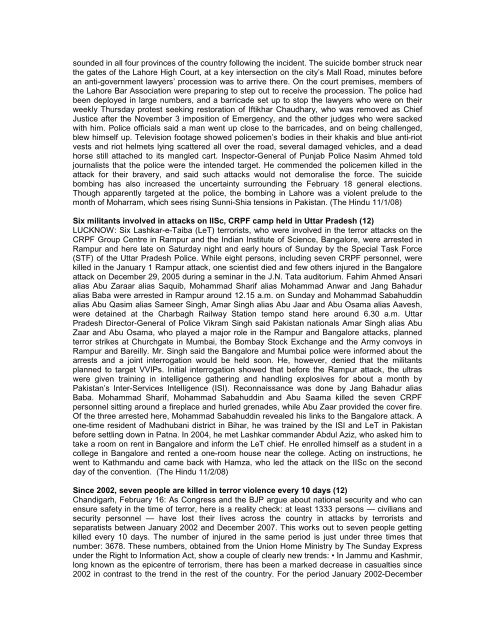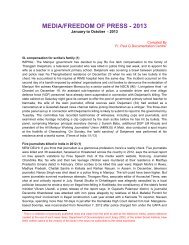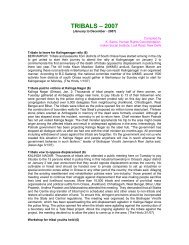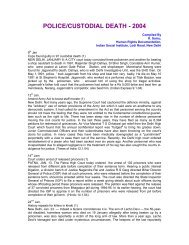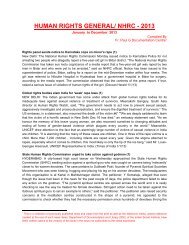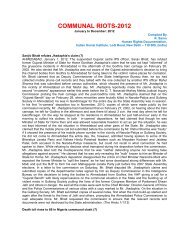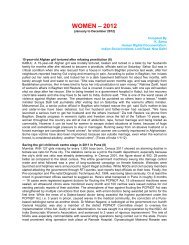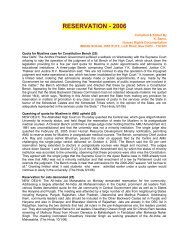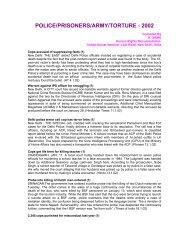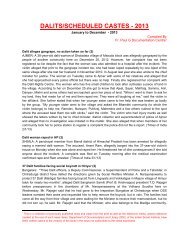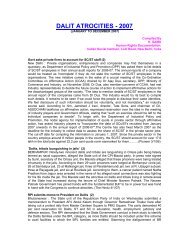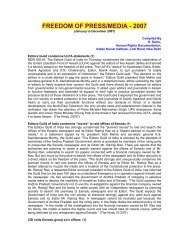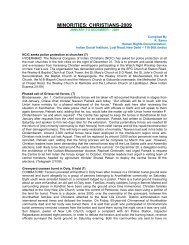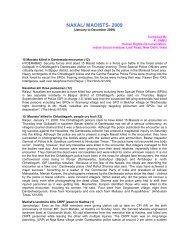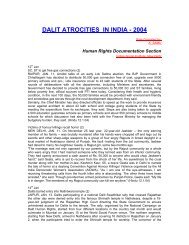TERRORISM - 2008 - Indian Social Institute
TERRORISM - 2008 - Indian Social Institute
TERRORISM - 2008 - Indian Social Institute
You also want an ePaper? Increase the reach of your titles
YUMPU automatically turns print PDFs into web optimized ePapers that Google loves.
sounded in all four provinces of the country following the incident. The suicide bomber struck near<br />
the gates of the Lahore High Court, at a key intersection on the city’s Mall Road, minutes before<br />
an anti-government lawyers’ procession was to arrive there. On the court premises, members of<br />
the Lahore Bar Association were preparing to step out to receive the procession. The police had<br />
been deployed in large numbers, and a barricade set up to stop the lawyers who were on their<br />
weekly Thursday protest seeking restoration of Iftikhar Chaudhary, who was removed as Chief<br />
Justice after the November 3 imposition of Emergency, and the other judges who were sacked<br />
with him. Police officials said a man went up close to the barricades, and on being challenged,<br />
blew himself up. Television footage showed policemen’s bodies in their khakis and blue anti-riot<br />
vests and riot helmets lying scattered all over the road, several damaged vehicles, and a dead<br />
horse still attached to its mangled cart. Inspector-General of Punjab Police Nasim Ahmed told<br />
journalists that the police were the intended target. He commended the policemen killed in the<br />
attack for their bravery, and said such attacks would not demoralise the force. The suicide<br />
bombing has also increased the uncertainty surrounding the February 18 general elections.<br />
Though apparently targeted at the police, the bombing in Lahore was a violent prelude to the<br />
month of Moharram, which sees rising Sunni-Shia tensions in Pakistan. (The Hindu 11/1/08)<br />
Six militants involved in attacks on IISc, CRPF camp held in Uttar Pradesh (12)<br />
LUCKNOW: Six Lashkar-e-Taiba (LeT) terrorists, who were involved in the terror attacks on the<br />
CRPF Group Centre in Rampur and the <strong>Indian</strong> <strong>Institute</strong> of Science, Bangalore, were arrested in<br />
Rampur and here late on Saturday night and early hours of Sunday by the Special Task Force<br />
(STF) of the Uttar Pradesh Police. While eight persons, including seven CRPF personnel, were<br />
killed in the January 1 Rampur attack, one scientist died and few others injured in the Bangalore<br />
attack on December 29, 2005 during a seminar in the J.N. Tata auditorium. Fahim Ahmed Ansari<br />
alias Abu Zaraar alias Saquib, Mohammad Sharif alias Mohammad Anwar and Jang Bahadur<br />
alias Baba were arrested in Rampur around 12.15 a.m. on Sunday and Mohammad Sabahuddin<br />
alias Abu Qasim alias Sameer Singh, Amar Singh alias Abu Jaar and Abu Osama alias Aavesh,<br />
were detained at the Charbagh Railway Station tempo stand here around 6.30 a.m. Uttar<br />
Pradesh Director-General of Police Vikram Singh said Pakistan nationals Amar Singh alias Abu<br />
Zaar and Abu Osama, who played a major role in the Rampur and Bangalore attacks, planned<br />
terror strikes at Churchgate in Mumbai, the Bombay Stock Exchange and the Army convoys in<br />
Rampur and Bareilly. Mr. Singh said the Bangalore and Mumbai police were informed about the<br />
arrests and a joint interrogation would be held soon. He, however, denied that the militants<br />
planned to target VVIPs. Initial interrogation showed that before the Rampur attack, the ultras<br />
were given training in intelligence gathering and handling explosives for about a month by<br />
Pakistan’s Inter-Services Intelligence (ISI). Reconnaissance was done by Jang Bahadur alias<br />
Baba. Mohammad Sharif, Mohammad Sabahuddin and Abu Saama killed the seven CRPF<br />
personnel sitting around a fireplace and hurled grenades, while Abu Zaar provided the cover fire.<br />
Of the three arrested here, Mohammad Sabahuddin revealed his links to the Bangalore attack. A<br />
one-time resident of Madhubani district in Bihar, he was trained by the ISI and LeT in Pakistan<br />
before settling down in Patna. In 2004, he met Lashkar commander Abdul Aziz, who asked him to<br />
take a room on rent in Bangalore and inform the LeT chief. He enrolled himself as a student in a<br />
college in Bangalore and rented a one-room house near the college. Acting on instructions, he<br />
went to Kathmandu and came back with Hamza, who led the attack on the IISc on the second<br />
day of the convention. (The Hindu 11/2/08)<br />
Since 2002, seven people are killed in terror violence every 10 days (12)<br />
Chandigarh, February 16: As Congress and the BJP argue about national security and who can<br />
ensure safety in the time of terror, here is a reality check: at least 1333 persons — civilians and<br />
security personnel — have lost their lives across the country in attacks by terrorists and<br />
separatists between January 2002 and December 2007. This works out to seven people getting<br />
killed every 10 days. The number of injured in the same period is just under three times that<br />
number: 3678. These numbers, obtained from the Union Home Ministry by The Sunday Express<br />
under the Right to Information Act, show a couple of clearly new trends: • In Jammu and Kashmir,<br />
long known as the epicentre of terrorism, there has been a marked decrease in casualties since<br />
2002 in contrast to the trend in the rest of the country. For the period January 2002-December


